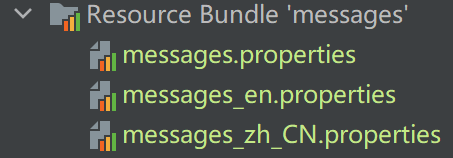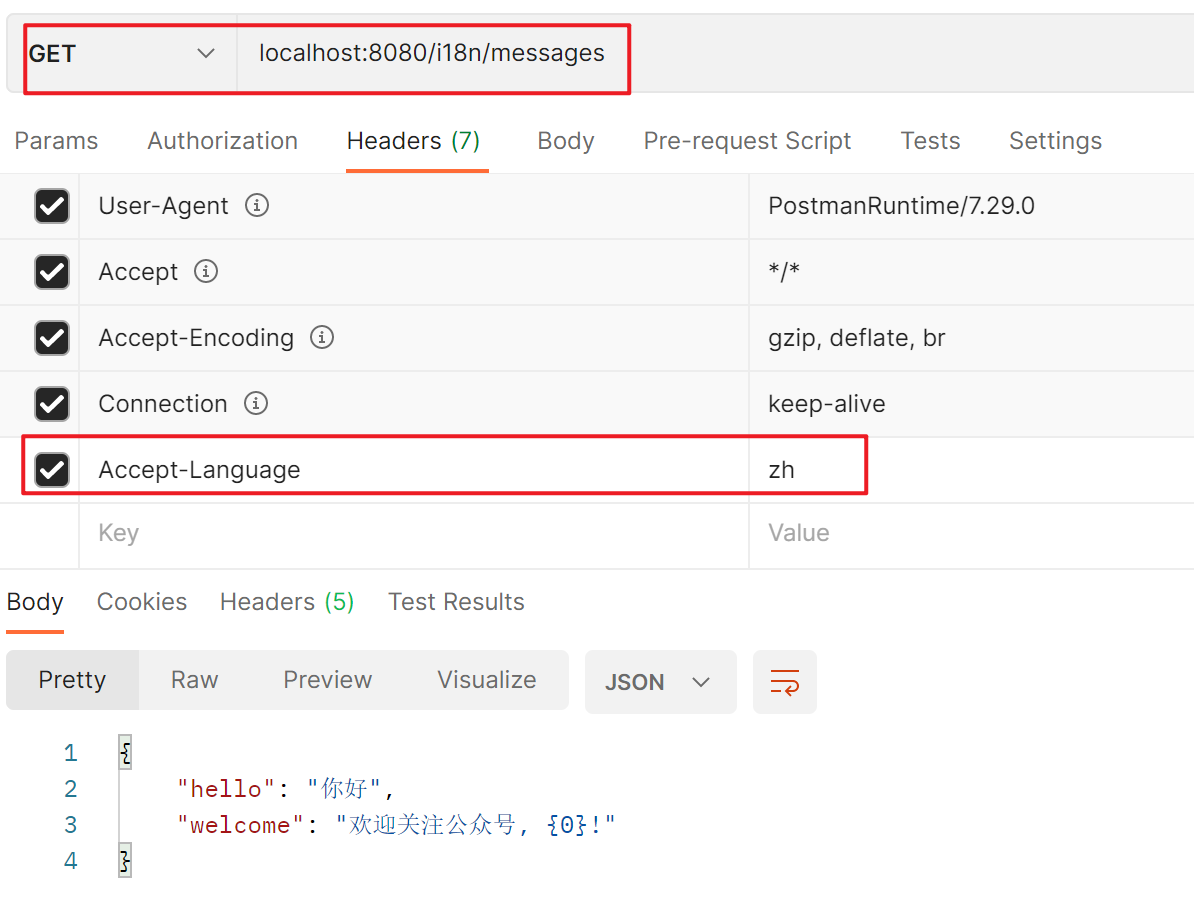前些天发现了一个巨牛的人工智能学习网站,通俗易懂,风趣幽默,忍不住分享一下给大家。点击跳转到网站。
什么是国际化
国际化(Internationalization) 是指为了适应不同语言、文化和地区的用户,使软件能够方便地进行本地化修改的过程。
国际化(Internationalization) 简称i18n,其中 “i” 是Internationalization的首字母 ,“n” 是最后一个字母 , “18” 代表了中间省略的18个字母。
SpringBoot 国际化
SpringBoot也提供了国际化的功能,在Spring Boot中,国际化通常涉及以下几个关键组件:
-
资源文件(Properties文件):这些文件包含了不同语言的文本消息,每个语言对应一个资源文件。通常,资源文件的命名采用
messages_语言代码.properties的格式,例如messages_en.properties(英语)、messages_zh_CN.properties(简体中文)等。 -
MessageSource接口:这是Spring框架提供的一个核心接口,定义了获取文本消息的方法。它的实现类负责加载并解析资源文件,并根据语言和代码来返回相应的消息。
-
LocaleResolver接口:这是Spring框架提供的另一个接口,用于解析用户的语言偏好。根据用户的设置,LocaleResolver可以确定要使用哪个语言。
-
组件中使用的文本消息:在应用程序的界面和代码中,您可以使用特定的消息代码来引用资源文件中的文本消息。Spring Boot会根据用户的语言偏好选择合适的消息进行显示。
通过配置MessageSource和LocaleResolver,以及在应用程序中使用相应的消息代码,就可以实现Spring Boot的国际化功能。
实践出真知
话不多说,上代码。

新建Properties文件
先Resource目录下新建Properties文件
- 中文properties文件 messages_zh_CN.properties :
hello=你好
welcome=欢迎关注公众号, {0}!
- 英文properties文件 messages_en.properties:
hello=hi
welcome=Welcome to follow WeChat Public Number, {0}!
创建完文件idea会自动将国际化文件归类到Resource Bundle中

修改配置文件
application.properties:
# 国际化
# 默认名称,可以写多个,用逗号分隔
spring.messages.basename=messages_zh_CN
spring.messages.encoding=UTF-8
# 找不到对应区域的语言时,是否回退到系统区域的语言,默认 true
spring.messages.fallback-to-system-locale=false
# 找不到code时,是否直接返回code值,而不是抛异常,默认false,抛异常
spring.messages.use-code-as-default-message=true
# 是否始终使用MessageFormat格式化国际化消息,即使没有国际化消息参数,默认false
spring.messages.always-use-message-format=false
# 加载国际化资源后的过期时间,不设置不过期,单位秒
#spring.messages.cache-duration=
测试
@Resource
private MessageSource messageSource;
@Test
void testMessageSource() {
Locale china = Locale.CHINA;
System.out.println("\n中文环境");
//中文语言
String hello_zh = messageSource.getMessage("hello", null, china);
System.out.println(hello_zh);
// 占位符替换
String welcome_zh = messageSource.getMessage("welcome", new String[]{"索码理"}, china);
System.out.println(welcome_zh);
//英文语言
Locale english = Locale.ENGLISH;
System.out.println("\n英文环境");
String hello_en = messageSource.getMessage("hello", null, english);
System.out.println(hello_en);
String welcome_en = messageSource.getMessage("welcome", new String[]{"suncodernote"}, english);
System.out.println(welcome_en);
System.out.println("\n没有对应语言的国际化属性,返回code");
//没有对应语言的国际化属性,返回code
String hello_test = messageSource.getMessage("hello-test", null, china);
System.out.println(hello_test);
System.out.println("\n没有对应语言的国际化区域时,返回默认语言");
//没有对应语言的国际化区域时,返回默认
String hello_fr = messageSource.getMessage("hello", null, Locale.FRANCE);
System.out.println(hello_fr);
}
测试结果:
中文环境
你好
欢迎关注公众号, 索码理!
英文环境
你好
欢迎关注公众号, suncodernote!
没有对应语言的国际化属性,返回code
hello-test
没有对应语言的国际化区域时,返回默认语言
你好
获取所有国际化资源
上面的测试我们都是只能根据一个code获取一个国际化信息,我们在切换语言使用国际化时,总不能每次进行国际化的时候都调用一次接口吧,这肯定是不行的。
下面是获取指定语言的所有的国际化信息的代码示例。
定义一个I18nService 接口:
public interface I18nService {
/**
* 获取指定语言所有国际化信息
* @param locale
* @return
*/
Map<String, String> getAllMessages(Locale locale);
}
I18nService 接口实现类
@Service
public class I18nServiceImpl implements I18nService{
@Autowired
private MessageSource messageSource;
@Override
public Map<String, String> getAllMessages(Locale locale) {
if (locale == null) {
locale = Locale.getDefault();
}
//存放所有message
Map<String, String> messages = new HashMap<>();
ResourceBundleMessageSource bundleMessageSource = (ResourceBundleMessageSource) messageSource;
String[] basenames = bundleMessageSource.getBasenameSet().toArray(new String[0]);
for (String basename : basenames) {
//从缓存中获取资源文件
ResourceBundle resourceBundle = ResourceBundle.getBundle(basename, locale);
//获取资源文件的所有code
Set<String> keys = resourceBundle.keySet();
for (String key : keys) {
//根据code获取对应的message
String message = messageSource.getMessage(key, null, locale);
messages.put(key, message);
}
}
return messages;
}
}
在getAllMessages方法中,拿到了指定资源文件的所有code,有了code再做一些操作就很方便了。比如获取以xxx开头的code。
I18nController:
@RequestMapping("/i18n")
@RestController
public class I18nController {
@Resource
private I18nService i18nService;
@RequestMapping("/messages")
public Map<String, String> getAllMessages(@RequestHeader(name = "Accept-Language" , required = false) Locale locale) {
return i18nService.getAllMessages(locale);
}
}
通过postman调用接口,将请求头 Accept-Language 设置为 zh 获取中文国际化环境,测试结果如下图所示:

以上就是SpringBoot 国际化一个简单的实现的操作步骤,感兴趣的可以动手试试。
总结
本文介绍了SpringBoot 国际化功能的简单使用,通过在资源文件中配置国际化字段,然后获取对应区域的国际化信息。这些操作都是静态的,要预先配置好国际化信息才能进行一系列的操作,不够灵活,下篇文章将介绍一下动态的国际化配置,敬请关注。






















 2218
2218











 被折叠的 条评论
为什么被折叠?
被折叠的 条评论
为什么被折叠?










